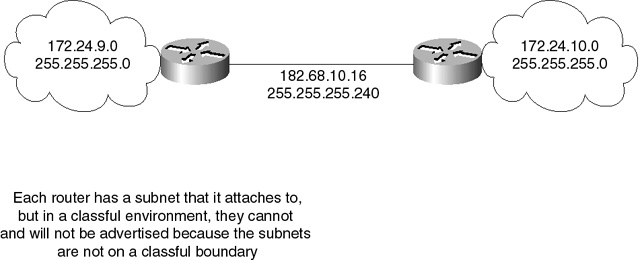Networking Routing Fundamentals
Explaining the Need for VLSM and CIDRVLSM (variable-length subnet mask) is defined as the capability to specify a different subnet mask for the same network number on different subnets. VLSM can help optimize available address space. CIDR (classless interdomain routing) is a technique supported by BGP4 and based on route aggregation. CIDR enables routers to group routes to cut down on the quantity of routing information carried by the core routers. With CIDR, several IP networks appear to networks outside the group as a single, larger entity. Why are VLSM and CIDR needed? This question can be answered in three words—IP address depletion. However, what does this mean? It means that the current IP address scheme, which is known as IPv4, is beginning to run out of IP addresses. This is an unacceptable situation that many network engineers have to deal with every day. However, relief for this problem is discussed in Chapter 12, “Future Network Considerations,” later in the book. CDR and VLSM are just interim solutions but effective nonetheless.
I am certain that when this addressing scheme was first designed many years ago, the engineers at that time believed it would be more than enough. Nevertheless, the recent explosive growth of the Internet and corporate intranets has made it necessary for new technology and strategies to deal with this looming problem. The situation becomes even more critical when you consider that corporations of all sizes are beginning to use and look to the Internet as a means of revenue. It’s a very exciting time for our field when you consider that less than fifteen years ago, computers and networks were things of ponderous size with only specific applications. This is a time of constant change and advancement, and it is interesting to consider what the world of technology will be like for the next generation. One of the most interesting enhancements on the horizon is IP version 6 (IPv6), also known as IP next generation (IPng) during its developmental stage. This is a move to improve the existing IPv4 implementation, which is quickly reaching critical mass. The proposal was released in July 1992 at the Boston Internet Engineering Task Force (IETF) meeting. IPv6 tackles issues such as the IP address depletion problem, quality of service capabilities, address autoconfiguration, authentication, and security capabilities. Because these issues are facing us in the here and now, it is in response to these concerns that the technologies of VLSM and CIDR were developed. Not only do these techniques enable us to better use the remaining IP addresses, but they have enabled large networks to continue growing without having the routers become saturated by the various routes within the network. A prime example of this is the Internet. This example will be discussed in further detail, but keep it in mind as you read through these sections. There are several items that are used within the discussions of VLSM and CIDR that are important to discuss before proceeding any further. Route Summarization (Aggregation or Supernetting)What is route summarization? This technique is known by several names, but simply described, it is a method of representing a series of network numbers in a single summary address that is advertised to other routers. Assume, for instance, that a router knows about the following networks that are attached to it: 172.24.100.0 172.24.101.0 172.24.102.0 172.24.103.0 The router would summarize that information to other routers by saying I know how to get to these networks in this summarization 172.24.100.0/22. You can also say that subnetting extends the prefix to the right by making the router know a very specific IP addresses; summarization, on the other hand, reduces the prefix to the left, thereby enabling the router to only advertise the higher order bits. Figure 2-5 demonstrates how subnetting and route summarization differ.
An example of this technique is classless interdomain routing (CIDR), which is discussed in detail in a later section of this chapter. There are a few requirements that you should keep in mind in order to have route summarization work properly:
Classful RoutingClassful routing always summarizes routes by the major network numbers. RIP and IGRP are protocols that use this type of routing. They are called classful because they always consider the network class. This is always done at network boundaries. The Impact of Classful Routing The use of classful routing has some considerable impact on a network. For one thing, subnets are not advertised to a different major network. In addition, noncontiguous subnets are not visible to each other. Figure 2-6 illustrates how classful routing and subnetting can affect your network.
There are certain techniques that have been developed to assist in overcoming this problem: IP unnumbered, secondary addressing, and using OSPF. Further discussion of classful routing and the issues surrounding its use (that is, discontiguous subnets) are beyond the scope of this book.
|
EAN: 2147483647
Pages: 200

